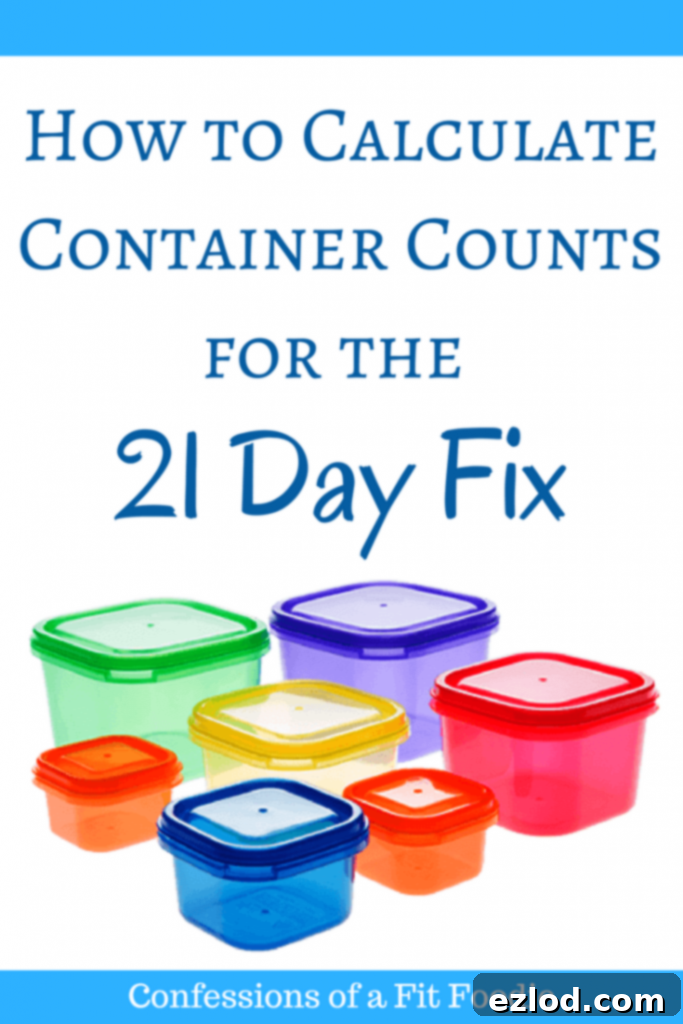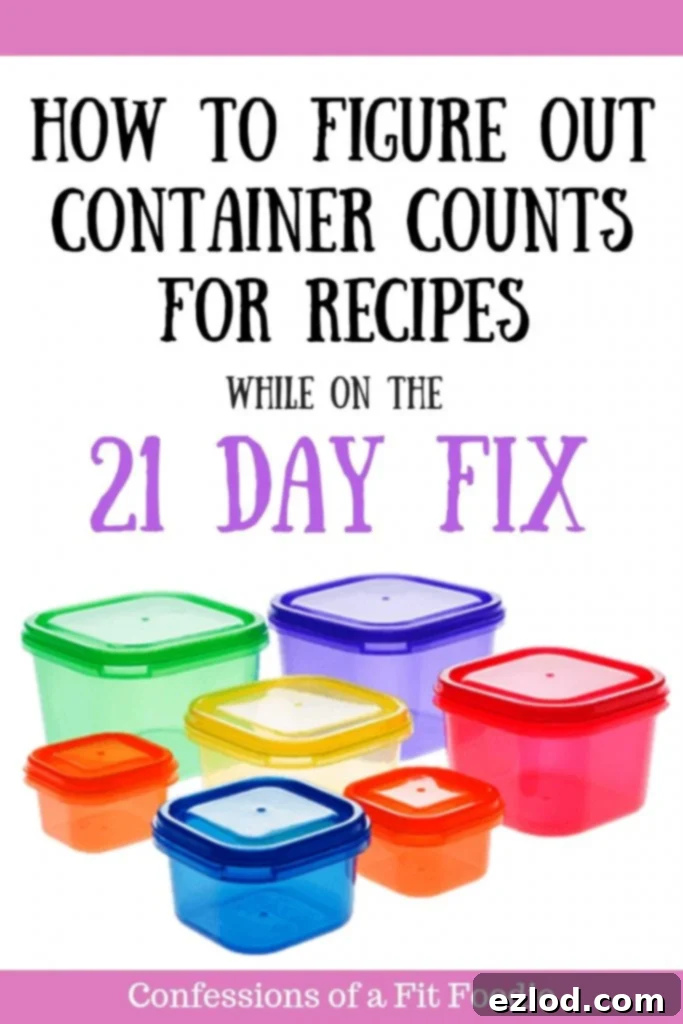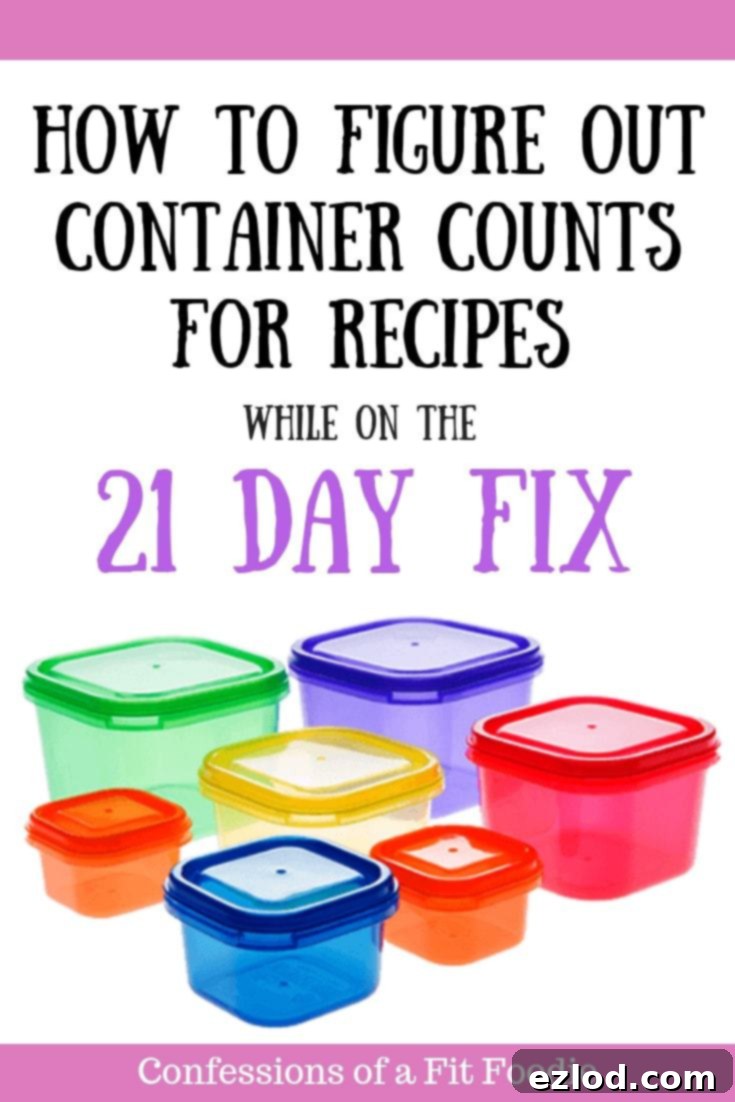Mastering 21 Day Fix Container Calculations: Your Step-by-Step Guide for Any Recipe
Are you a fan of the 21 Day Fix program but often find yourself puzzled by how to accurately calculate container counts for your favorite recipes? Especially those delicious, “mixed-together” dishes like hearty soups, comforting casseroles, or savory chilis where different food groups seem to blend into one? You are definitely not alone! This is one of the most frequently asked questions within the 21 Day Fix community, and the excellent news is, it’s far simpler and more straightforward than you might initially think.

Learning to break down any recipe into its corresponding 21 Day Fix container counts is an incredibly valuable skill that will empower you to take full control of your nutrition and meal planning journey. While our blog, Confessions of a Fit Foodie, meticulously provides pre-calculated container counts for all our original recipes, mastering this skill yourself opens up a vast world of culinary possibilities. You’ll be able to confidently adapt any cherished family favorite, try exciting new recipes you discover online, or even craft your own unique Fix-approved meals with absolute precision. Say goodbye to the guesswork and get ready to become a true container calculation expert!
Why Learning to Calculate Containers is Essential for Your 21 Day Fix Journey
For countless individuals, the 21 Day Fix program serves as a revolutionary tool for understanding proper portion control and fostering healthier eating habits. However, a significant hurdle for many can be translating complex, multi-ingredient recipes into the program’s intuitive, color-coded container system. Here’s a deeper look into why investing your time in learning this calculation method is so incredibly crucial for your success:
- Empower Your Meal Planning: Imagine no longer being restricted to only recipes that explicitly list 21 Day Fix counts. This skill liberates you to adapt virtually any recipe – from a beloved family cookbook to a trending dish on social media – making your meal planning infinitely more flexible and enjoyable.
- Ensure Pinpoint Accuracy for Optimal Results: Relying on estimations or guesswork for container counts can inadvertently lead to either under-eating or over-eating, both of which can significantly hinder your progress toward your health and fitness goals. Precise calculations ensure you are consistently and accurately adhering to your personalized nutritional targets.
- Deepen Your Nutritional Understanding: The act of meticulously breaking down each ingredient in a recipe forces you to critically identify food groups and their respective container values. This hands-on knowledge extends far beyond the duration of the program, fostering a more profound and intuitive understanding of healthy eating that promotes sustainable lifestyle changes.
- Increase Recipe Versatility and Enjoyment: Envision the freedom of indulging in a hearty pot of homemade chicken noodle soup or a comforting pan of lasagna without any accompanying stress, knowing with absolute certainty exactly how each delicious serving seamlessly integrates into your daily plan. This vastly expands your culinary repertoire.
- Save Valuable Time and Reduce Frustration: While the initial learning curve for mastering container calculations requires a small investment of effort, in the long run, you will experience substantial time savings. You’ll eliminate the need to constantly search for pre-calculated recipes or feel lost and overwhelmed when faced with cooking something entirely new or adapting an old favorite.
Understanding the 21 Day Fix Container System: A Quick Refresher
Before we dive into the practical calculation method, let’s take a moment for a quick yet comprehensive review of what each of the distinct, colorful 21 Day Fix containers represents. This foundational knowledge will be absolutely vital for accurately assigning container values to all the ingredients in your recipes:
- Green Container: Vegetables. This vibrant container is designated for an abundance of non-starchy vegetables such as leafy greens (spinach, kale), crisp bell peppers, nutrient-rich broccoli, crunchy carrots, and many more.
- Red Container: Proteins. The red container signifies your lean protein sources, including lean meats (chicken breast, turkey), poultry, various types of fish, eggs, Greek yogurt, cottage cheese, and protein powder.
- Yellow Container: Carbohydrates. This container is for your healthy carbohydrates, encompassing whole grains (quinoa, brown rice), starchy vegetables (sweet potatoes, corn), legumes (beans, lentils), and specific approved breads or tortillas.
- Blue Container: Healthy Fats & Dairy. The blue container is dedicated to healthy fats and certain dairy products, with common examples being creamy avocado, various cheeses, nuts, seeds (in smaller quantities), and hummus.
- Purple Container: Fruits. This container is for all kinds of delicious fresh or frozen fruits, ranging from juicy berries and crisp apples to sweet bananas and tangy oranges.
- Orange Container: Seeds & Dressings. The orange container holds smaller portions of nutrient-dense foods like pumpkin seeds, sunflower seeds, and certain approved salad dressings.
- Teaspoons: Oils & Nut Butters. Unlike the other food groups that use containers, oils (like olive oil, coconut oil) and nut butters (peanut butter, almond butter) are measured precisely by the teaspoon for accurate tracking.
Having a clear visual guide or a readily accessible printable food list, such as our comprehensive 21 Day Fix Updated Food List, will be incredibly helpful when you’re initially starting out, and it remains a fantastic resource for quick reference throughout your journey.

The Simple 2-Step Method to Calculate 21 Day Fix Containers for Any Recipe
Are you ready to finally demystify those daunting mixed recipes and unlock a new level of confidence in your meal prep? It all boils down to two straightforward, easy-to-follow steps. Let’s walk through them together, using a highly popular and beloved example from our very own site: the 21 Day Fix Mexican Lasagna. This fantastic casserole is packed with layers of tortillas, vibrant veggies, rich cheese, and savory meat, making it an ideal candidate for demonstrating our calculation method.

Step 1: Tally Up the Total Container Count for Each Ingredient in the Entire Recipe
This foundational first step involves meticulously going through your chosen recipe’s ingredient list and assigning the appropriate 21 Day Fix container value to the *total amount* of each individual ingredient used. Think of this as creating a comprehensive nutritional inventory of your entire finished dish before it’s portioned out. Having your 21 Day Fix Container Sizes document or the updated food list readily available is extremely helpful during this process.
Crucial Measurement Tip: Be Precise! Many ingredients experience changes in volume when they are chopped, cooked, or shredded. It’s always best practice to measure ingredients in their final, prepared state as they would appear when placed into the container, if feasible. Alternatively, use reliable conversions. For example, a medium onion might seem modest in size before chopping, but once finely diced, it frequently yields more volume than you might initially anticipate. Don’t eyeball; measure!
Example: Mexican Lasagna Ingredient Breakdown
- 2 Bell Peppers: 2 GREEN. (Through extensive personal measurement over the years, I’ve consistently found that one average-sized medium bell pepper, once chopped, typically fills one Green container perfectly.)
- 1 Medium Onion: 2 GREEN. (Do not underestimate the volume of onions! A single medium onion, once finely chopped, very often yields a surprising two full Green containers. Always make sure to measure if you have any doubts!)
- 1 lb Lean Ground Sirloin (or other lean protein): 4 RED. (A dependable rule of thumb suggests that 1 pound of cooked, lean meat generally equates to 4 Red containers. While this can fluctuate slightly based on the specific type and leanness of the meat, it serves as an excellent starting point for your calculations.)
- 2 T Salt-Free Taco Seasoning: FREE. (Seasonings that are free from added salt, sugar, or artificial ingredients are typically classified as free foods, meaning they do not contribute to your daily container totals.)
- 1 1/3 cups Shredded Cheddar Cheese: 4 BLUE. (Always remember that cheese, while delicious, falls under the healthy fats category and should be precisely measured to stay within your allotted Blue container servings.)
- 3/4 cup Refried Beans: 1.5 YELLOW. (Beans are a carbohydrate source, placing them squarely in the Yellow container category. Be sure to measure this amount with accuracy!)
- 1/4 cup Corn: 0.5 YELLOW. (Corn is considered a starchy vegetable, therefore it counts as a Yellow container. Even seemingly small quantities can add up, so track carefully.)
- 1 (15 oz) can of Rotel (diced tomatoes with green chilies): 2 GREEN. (For comprehensive guidance on selecting healthy, FIX-approved canned tomato products, you can refer to this helpful post.)
- Olive Oil Cooking Spray: FREE. (Similar to salt-free seasonings, cooking sprays are generally considered free when used sparingly to prevent sticking, and do not count towards your teaspoons.)
- 8 Gluten-Free Corn Tortillas, cut in half: 4 YELLOW. (According to the 21 Day Fix guidelines, two 6-inch corn tortillas typically equate to one Yellow container serving.)
- Cilantro (for topping): FREE. (Fresh herbs like cilantro are a fantastic way to infuse flavor into your dishes without adding any container counts, making them a healthy and flavorful addition.)
- 2/3 cup Diced Avocado (for topping): 2 BLUE. (Avocado is an exceptional source of healthy fats, but it is also calorie-dense. Therefore, precise measurement is absolutely crucial for accurately tracking your Blue container intake.)
Total Container Amounts for the Entire Mexican Lasagna Recipe:
- Teaspoons: 0 (This recipe primarily uses cooking spray and free seasonings, so no measurable oils or nut butters contribute to this count.)
- Greens: 6 (Derived from 2 bell peppers + 2 onion + 2 Rotel)
- Reds: 4 (Coming from 1 lb of lean ground sirloin)
- Yellows: 6 (A combination of 1.5 refried beans + 0.5 corn + 4 tortillas)
- Blues: 6 (Including 4 from shredded cheddar cheese + 2 from the avocado topping)
- Purples: 0 (No fruit ingredients are included in this specific recipe)
- Oranges: 0 (This recipe does not feature any seeds or specific dressings that count as orange containers)
Now that you have meticulously compiled a comprehensive tally of every container group present in your entire delicious dish, you are perfectly equipped and ready to seamlessly transition to the crucial second step of our calculation process!
Step 2: Divide the Total Container Counts by the Number of Servings
This pivotal step is where you efficiently translate the recipe’s overall nutritional value, which you painstakingly calculated in Step 1, into convenient, manageable, and precise per-serving container counts for your daily tracking. Once you have the aggregate total of each container type for the entire prepared dish, the process is quite simple: you just divide each total by the exact number of servings your recipe is intended to yield.
How Do I Accurately Determine the Number of Servings for My Recipe?
This is indeed a critical and frequently asked question! If you are preparing a recipe obtained from a reputable cookbook or an online source, the serving size and total number of servings are typically explicitly provided. However, if these details are absent, or if you are creatively adapting a cherished family recipe, you will need to make an informed and thoughtful decision:
- Carefully Consider the Total Volume: Take a moment to assess the entire quantity of food produced by the recipe. Is it a generously sized casserole that could comfortably feed a large gathering, or is it a more modest dish suitable for just a few individual meals? Your answer will guide your serving estimate.
- Start with Common Divisions and Adjust: I frequently initiate my estimation process by calculating for 4 standard servings and then meticulously observe how the resulting container counts are distributed per serving. If I find that this division results in portions that are excessively large, or that require too many containers for a single meal according to my personal plan, I will then strategically try dividing the recipe by 6, or even 8, to achieve a more balanced outcome.
- Aim for Balanced and Satisfying Portions: Reflect on what constitutes a reasonable, satisfying, and authentically Fix-approved meal portion specifically tailored for *your* particular plan level. The objective is to ensure each serving feels substantial enough to satisfy you without becoming overwhelming or exceeding your daily allocations.
- Implement Physical Division for Consistency: Once the dish is completely cooked, proceed to physically divide it into equal portions to ensure consistency. For a casserole, you can neatly cut it into precise squares or rectangles. For liquid-based dishes like soups or stews, utilize a reliable measuring cup to guarantee that each serving is consistently sized (e.g., aiming for 1.5 cups per serving).
Example: Mexican Lasagna Per-Serving Calculation Breakdown
Our featured Mexican Lasagna recipe is specifically designed to yield 6 satisfying servings. Let’s now apply the total container counts we meticulously determined in Step 1 to this number of servings:
- Greens: 6 total ÷ 6 servings = 1 Green per serving
- Reds: 4 total ÷ 6 servings = 2/3 Red per serving
- Yellows: 6 total ÷ 6 servings = 1 Yellow per serving
- Blues: 6 total ÷ 6 servings = 1 Blue per serving
Based on these calculations, for each perfectly proportioned 1 ¼ cup serving of this absolutely delicious Mexican Lasagna, you would accurately count: 1 Green, 2/3 Red, 1 Yellow, and 1 Blue.
What About Fractional Container Counts? Please do not allow fractional counts, such as “2/3 Red” or “1/2 Yellow,” to intimidate you! You have several practical options for managing them: you can simply visually estimate the slightly less than full container, or you might realize that another component of your current meal or an upcoming snack can provide that remaining “1/3 Red” or “1/2 Yellow.” With consistent practice, you’ll develop a keen eye for approximating these smaller amounts confidently.
As you can see, it’s truly as simple and logical as that! With consistent practice and application, these container calculations will swiftly become second nature, granting you an incredible degree of flexibility and control within your healthy eating plan.
Frequently Asked Questions About 21 Day Fix Container Calculations
How Do I Know if the Ingredients in My Recipe Are FIX Approved?
Understanding ingredient approval is a fundamental cornerstone of the 21 Day Fix program. Always, without exception, consult your official and most current 21 Day Fix Updated Food List. It serves as your definitive guide for making informed food choices! Generally, the program strongly advocates for the consumption of whole, unprocessed foods. Therefore, when reviewing ingredients, always scrutinize for minimal or no added sugars, artificial sweeteners, unhealthy trans fats, or excessive sodium. When incorporating canned goods like Rotel, make it a habit to meticulously check the nutritional label for any hidden ingredients that might not align with Fix-approved guidelines. The cleaner and shorter the ingredient list, the better it typically is for your plan!
If I See a Recipe on Pinterest or Another Blog, How Do I Know if the 21 Day Fix Container Counts Are Correct?
Regrettably, you cannot automatically assume accuracy without performing your own verification! While many dedicated creators (including all of us here at Confessions of a Fit Foodie) diligently strive for utmost accuracy in our recipe calculations, genuine mistakes can occasionally occur. Furthermore, differing interpretations of the 21 Day Fix program guidelines or various versions of the plan itself can sometimes lead to discrepancies in reported container counts. I personally engage in a rigorous process of double and even triple-checking all my container counts before any recipe is published. However, I have, on numerous occasions, encountered countless recipes on platforms like Pinterest and even in what appear to be official-looking guides that contain incorrect container counts. Always adopt a critical approach and exercise caution, especially when sourcing information from unfamiliar platforms or individuals. Your hard-earned results are directly dependent on precise tracking, so empowering yourself with the knowledge and confidence to verify these counts independently is absolutely paramount to safeguarding your progress!
What About “Free” Foods and Condiments in the 21 Day Fix?
The 21 Day Fix program thoughtfully includes a specific list of “free” foods. This designation signifies that these items, when used prudently and in moderation, do not count towards your daily container totals. This valuable category typically includes items such as:
- Plain water, unsweetened tea, and black coffee
- An array of fresh herbs and dried spices (ensure they are salt-free and sugar-free)
- Fresh lemon and lime juice
- Various types of vinegar (including apple cider, balsamic, and red wine vinegar)
- Garlic, onion powder, chili powder, and other pure seasonings
- Mustard and hot sauce (verify they are sugar-free)
- Zero-calorie sweeteners (to be used sparingly)
- Cooking spray (utilized lightly to prevent food from sticking)
While these items are indeed “free,” it is always a wise strategy to use them mindfully and in sensible quantities. For example, while drenching your food in sugar-free hot sauce may not technically add to your container counts, it could potentially lead to an excessive intake of sodium. The overarching goal of the 21 Day Fix is to promote wholesome, balanced, and sustainable eating habits.
Beyond the Basics: Tips for Advanced Container Tracking & Meal Prep
Once you’ve become comfortable and proficient with the fundamental 2-step calculation method, consider integrating these advanced tips to further streamline and optimize your 21 Day Fix journey, making healthy eating even more manageable and effective:
- Leverage Batch Cooking & Efficient Meal Prep: Calculating the container counts for a large batch of your favorite soup, chili, or casserole is an absolute game-changer for weekly meal preparation. You have the efficiency of cooking just once, performing the calculations once, and then simply portioning out your perfectly measured meals throughout the entire week, saving immense time and effort.
- Confidently Handle Fractional Container Counts: When your calculations result in fractional amounts like “2/3 Red” or “1/2 Yellow,” there’s no need to feel stressed or overwhelmed. You can either visually estimate the slightly less than full container, or, even better, you might realize that another component of your current meal, or an upcoming snack later in the day, can conveniently provide that missing fraction. With consistent practice, you’ll naturally develop a better intuition for estimating these smaller amounts.
- Integrate with Digital Tracking Apps: If you currently utilize a digital tracking application (such as the Beachbody On Demand app or MyFitnessPal) to log your daily food intake, meticulously inputting your custom-calculated container counts for homemade recipes will ensure that your logs are exceptionally precise and accurately reflect the true nutritional value of your prepared meals.
- Practice Mindful Eating & Listen to Your Body: While the 21 Day Fix containers provide an outstanding, structured framework for portion control, it is equally important to tune into and honor your body’s inherent hunger and fullness cues. If you consistently find yourself feeling excessively hungry after meals or uncomfortably stuffed, it might be beneficial to slightly adjust your portion sizes (always remaining within your plan’s established guidelines, of course) or to re-evaluate your initial serving division for that particular recipe.
Still Feeling Overwhelmed? Let Us Help!
It is completely understandable and entirely normal for container calculations to feel a bit daunting or complex when you’re first starting out. However, please remember this vital truth: it truly, genuinely gets easier and more intuitive with consistent practice! The more recipes you thoughtfully break down and calculate, the more ingrained and second nature the entire process will become. And as always, remember that every single one of my recipes right here on Confessions of a Fit Foodie already has the container counts meticulously figured out and clearly presented for you, specifically designed to make your healthy eating journey as straightforward and enjoyable as possible!
If you’re eager to discover even more incredibly delicious “mixed together” recipes that are already perfectly Fix-approved and have all their container counts conveniently ready for you, be sure to explore some of these highly popular and beloved favorites from our collection:
- Baked Eggplant Parmesan
- Instant Pot Beanless Chili
- Healthy Instant Pot Baked Ziti
- Cauliflower Cheeseburger Mac
- Zuppa Toscana
- Instant Pot Jambalaya
- Healthy Chicken Ramen Noodle Stir Fry
Explore More Essential 21 Day Fix Resources
To further bolster your health and fitness journey and to thoroughly address any lingering questions you might have, we’ve curated some other exceptionally helpful 21 Day Fix posts and comprehensive guides:
- Updated 21 Day Fix Food List – Free Printable
- The Ultimate 21 Day Fix Container Guide | The Foodie and The Fix
- 21 Day Fix Container Sizes | Carrie Elle
- The Ultimate Portion Fix Recipe Guide | 31 Days of Ultimate Portion Fix Recipes
By diligently mastering these simple yet powerful container calculation steps and actively utilizing the wealth of resources made available to you, you will undoubtedly gain an unparalleled sense of confidence and autonomy in your 21 Day Fix journey. This newfound skill will empower you to enjoy a much wider and more diverse variety of wholesome foods, effortlessly adapt to any culinary situation that arises, and consistently stay firmly on track towards achieving all of your cherished health and fitness aspirations. Happy calculating, and enjoy your delicious, perfectly portioned meals!

